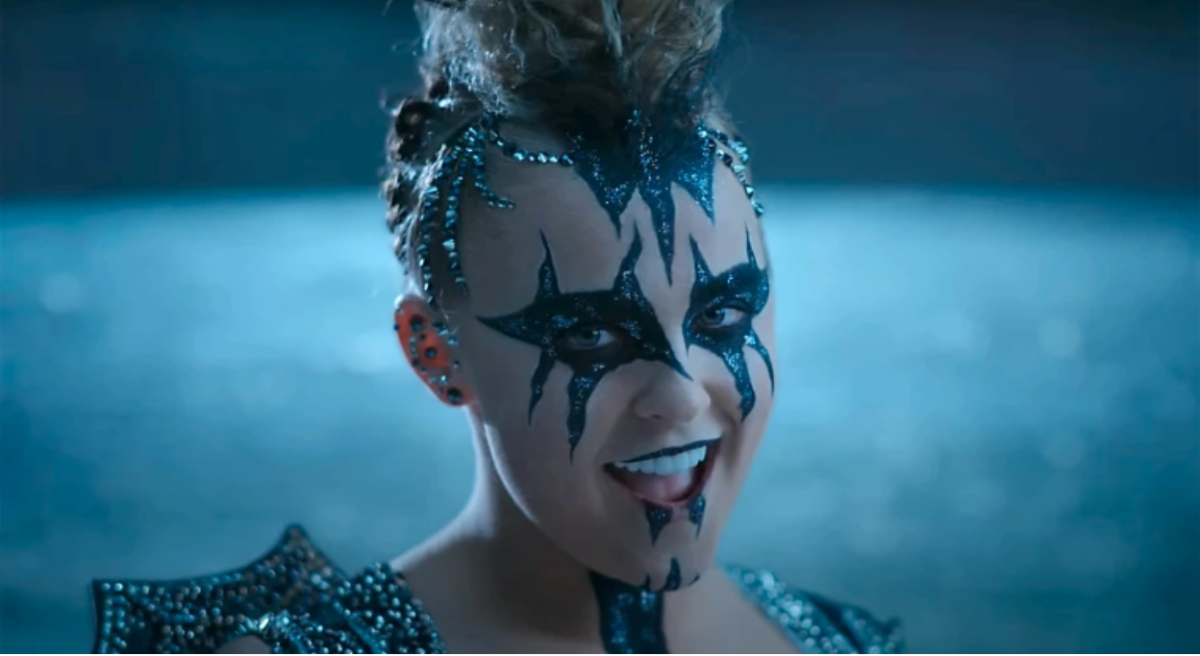Acquiring her fame originally from Abby Lee Miller’s Dance Moms, wearing elaborate bows and sporting platinum blonde high ponytails, pop star JoJo Siwa has begun her journey into a new realm of music. She has ditched the bows and has begun to wear grotesque, gothic makeup, signaling a change in her identity. Her new song, what JoJo believed to be a symbol of her newfound maturity, is callee “Karma” and is at the center of JoJo’s drastic transformation.
Long before the release of “Karma”, JoJo had been utilizing her substantial TikTok platform to hint at the big change in her identity, posting videos of her choreography and short clips from the music video. While this did create excitement and anticipation, allowing more people to become invested in the song, people became underwhelmed after the release, already familiar with most of the song beforehand–causing not only little new enthusiasm, but little positive feedback at all. This marked the beginning of the downfall of Karma. People began to mock JoJo’s provocative dancing in the music video. Though the song did rise on top charts such as reaching #3 on the U.S. iTunes chart, this attention was almost entirely due to pure ridicule.
This negative response grew even further in response to JoJo’s own discussion of her transition. She went so far as to compare herself to highly successful artists who have “undergone this big of a transition”, using Miley Cyrus and Elvis Presley as examples. Yet, people could not help but merely scoff at statements like these, claiming that JoJo’s transition was too forced to be as significant as that of pop stars Cyrus and Presley. So, is JoJo’s supposed identity transformation significant and worth acceptance, or is it simply just a phase for temporary media attention?
Who would have thought that Jojo Siwa would have turned from singing lighthearted kid centric songs to this? In her latest music video, there’s a notable eerie attire, marking a significant divergence from her previously recognizable wardrobe characterized by vibrance and colors. The lyrics in her song are extremely different from all her previous tracks, some including “Kid in a Candy Store” and “Boomerang”. Her drastic twist in music style is leaving many fans confused as the target market is not clear: a significant shortcoming of this transition.
She grew her career as a kids popstar, reaching a demographic of pre teens and younger. Now, fans are puzzled as to if this is targeted to mature adults or preteens. “Karma” includes profanity and inappropriate, sexual dancing, typically appealing to a mature audience, but JoJo’s whole career has been based in a youthful audience. Moreover, because JoJo’s transition feels superficial, true adults do not resonate with her, causing them to mock JoJo rather than enjoy her music.
The most profound and listened to lyric says,“I was a bad girl, I did some bad things”, but many people have found themselves wondering what things? What bad things could neon, glittery bow-wearing JoJo Siwa possibly have done? Unlike Cyrus and Presley, JoJo has not, in the eyes of the media, done anything dangerous or edgy besides her provocative dancing. This, too, has contributed to the mockery of “Karma” as listeners cannot help but feel that this transition is superficial as JoJo has not, in any notable way, actually changed despite her dark makeup and aggressive dancing–proving a stark contrast between true edgy artists, like Presley and Cyrus, and JoJo.
It did not help JoJo that soon after the song’s release, listeners discovered that “Karma” was not even the work of JoJo herself, but rather American singer, songwriter, actress, and model Brit Smith. Tik Tok users began to do a deep dive into the song, and they found proof that Siwa’s single was actually recorded in 2012 by Brit Smith. This not only resulted in users feeling deceived by Siwa, but this discovery actually fostered Smith’s growth as an artist. She began to surpass JoJo on top music charts, to the point where Smith’s recording of Karma became #8 on the iTunes charts while JoJo’s “Karma” became knocked off the list altogether.
We reached out to several Harriton students to share their perspectives on Siwas recent release of “Karma”, asking them to sum up their thoughts on the song in one word and to give opinions on where they think JoJo may have gone wrong. Emily Sandos ‘25 chose the word “spunky” and thinks that Jojo made a bad decision “by trying to change her whole self image too quickly for the media.” On a slightly more critical note, Megan McCloy ‘25 made it clear that the song is “annoying” and should not have released a music video without her signature bow. To Nina Cantor ‘25, the song came across as “uncomfortable” and she thinks that Jojo would have had better success with a different appearance, makeup and outfit wise.
Overall, Jojo’s first release of her new styled music came with a lot of backlash, yet still was a successful launch to some extent, achieving a significant amount of streams and temporarily high rankings on top music charts. Based on her social media posts, it does not seem like she is affected by the hate as she is already starting to release sneak peaks of new songs. Overall, this release has proven that yes, some artists successfully undergo drastic identity shifts and are able to find appreciation and acceptance in their respective industries; however, it is extremely risky and difficult to do so, often resulting in confusion and a loss of followers, as demonstrated by JoJo Siwa’s “Karma”.





